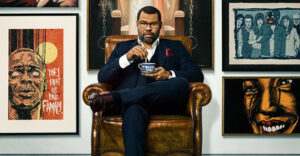
Black horror films are reaching new heights in the 21st century. The storyline isn’t only executed by black actors, but also by black producers and directors. It is through the lens of these visionaries that we challenge the visual landscape and resurrect the legacy of black art.
The release of the first blaxploitation horror film “Blacula” in 1972, under Black production, served as a precursor to the conversation of race in society. The film was directed by UCLA film school graduate William Crain and starred a majority Black cast, which created an avenue for Blacks in mainstream media.
Although it wasn’t the best quality, the film had memorable shots and raised awareness. The motif of vampirism in the film was present as a result of the long-term ramifications of slavery. Introducing Blacula as “Dracula’s Soul Brother” hinted to the black experience in America.
Most of all, this was a call to action for the black community to be empowered and rise above racism at such a liberating, yet suppressive time. It allowed the world to see just how diverse and talented black actors, actresses, and directors can be.
The same effect was revived in 2017 when Jordan Peele made his directorial debut with the horror film “Get Out.” This took the nation by storm because it was a combination of horror and romance. It also touched on the interactions between black and white Americans.
The film made audiences laugh, despite how uncomfortable the truth was. The “sunken place” carried the historic undertone of marginalized Black Americans who are exploited for their capabilities.
The following year, Peele won the Academy Award for Best Original Screenplay, as well as the Satellite Award for Best Director and the Critics’ Choice Movie Award for Best Sci-Fi/Horror Movie. These successive wins struck a new era for horror films in the hands of a black curator.
In an interview with Forbes contributing writer Scott Mendelson, Peele said, “We go to the theater to be entertained, but if what is left after you watch the movie is a sort of eye-opening perspective on some social issues, then it can be a really powerful piece of art.”
On March 22, 2019, Peele released “Us” starring acclaimed actress Lupita Nyong’o. The film takes place in two timelines: 1986 and the present day. The storyline is based on a Black family that has to fight for survival against “the Tethered,” their evil doppelgangers, on a family vacation.
The film took home the 2020’s NAACP Image Award for Outstanding Writing in a Motion Picture and the Critic’s Choice Movie Award for Best Sci-Fi/Horror Film. Lupita Nyong’o also received the 2020 NAACP Image Award for Outstanding Actress in a Motion Picture.
Both “Get Out” and “Us” are aesthetically appealing, thought-provoking because who is better to tell the Black experience, then it’s very own storyteller.
The newest Black horror film “Antebellum” is set to be released this spring. It takes place in the south during the beginning of the Civil War and stars singer Janelle Monae as the lead actress.
Author Veronica Henley (Monae) finds herself trapped in an uncompromising reality and she must discover the truth before it’s too late. According to the movie description, the film arrives from the same creative flair as “Get Out” and “Us”, however, this time a black woman is in this “sunken place”, leaving room for interpretation.
The reboot of the 1992 horror thriller “Candyman” will hit theaters on June 12. The revamp of the urban legend of “Candyman” in the modern gentrified apartment complexes of Chicago will be directed by Nia DaCosta and produced by Jordan Peele. From the trailer, millennials are highly significant, as well as the social pressure of the main character being a black artist. It seems as though his past revisits him to make a political and cultural statement.
With this evolution of Black horror films, the narratives have been transformed and history is being rewritten. This time around our stories is being told with truth, black representation, and achievement. The horror genre is evolving to become more inclusive of a wider spectrum of the human experience.
These black horror films are twisted fantasy vividly reflecting reality. The life and culture of African-Americans are being focused on and presented in innovative ways for the world to see. It stirs a dialogue on the black experience. The Jordan Peele’s and Nia DaCosta’s are leading a new wave of storytellers who are curating art that enhances the black legacy.